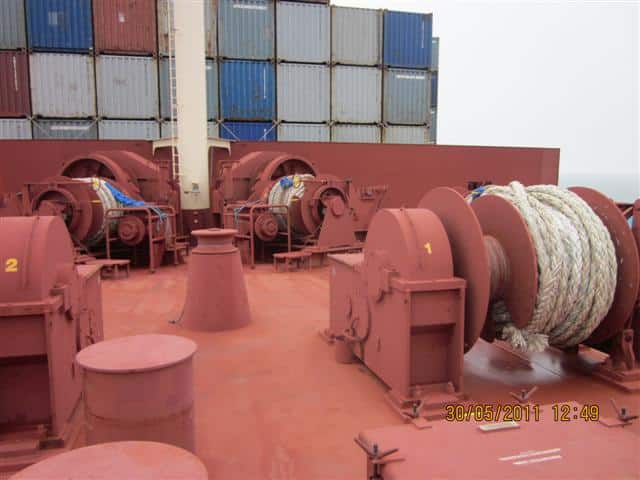10 Important Points to Remember During Mooring Operation On Ships
Mooring operation is one of the important tasks that seafarers have to perform on ship’s deck. Technically, the operation may seem simple but there are several dangerous associated with it. As a seafarer, you must have heard about “Death Traps” on ships and how crew members have lost lives during mooring operation.
Working on the ship’s deck is not an easy task. Deck crew has to consider various safety precautions and understand working of deck machinery and systems, along with cargo operation equipment. When it comes to mooring operations, additional precautions need to be taken to ensure personal and crew members’ safety.
Mentioned below are ten points that must be considered while handing mooring operation on ships:
1. Don’t Allow Any Extra Crew Member on the Deck: Ensure that no extra personnel are present at the mooring station except those who are involved in the operation. Anyone who is not assisting in the mooring operation must be asked to leave the mooring station for his/her and other’s safety.
2. Consider Weather Condition: Before planning the mooring operation, consider the weather condition by taking factors such as wind and current. The ship’s master and responsible officer must have the details of current and future weather data before commencing the mooring operation.
3. Have knowledge of Snap Back Zone and Rope Bight: All personnel involved with the mooring operation should be aware of the snap back zones and rope bight. Click here to know more about this.
4. Check All the Mooring Equipment: Check all the equipment (mooring winch, drums, windlass etc.) involved in the mooring operation for any kind of problem. Proper routine maintenance is the key to ensure smooth running of mooring equipment and systems. Don’t forget to check the load sensors of mooring winches.
5. Check the Tail of Mooring Line: If the mooring wire line is provided with tail (short lengths of synthetic fiber rope which are placed in series with the vessel’s winch-mounted wires to decrease mooring line stiffness and thus to reduce peak line loads and fatigue due to vessel motions) ensure same size and material of tails are used for all lines in the same service (breast, spring and head lines). Different tail size and material would lead to uneven load in the mooring line.
6. Tend One Line at a Time: Only one line should be tended at a time during mooring operation. If this is not done, it may increase the load in the other tended lines. If two lines are tended together it may lead to overloading and breakage. Follow the orders of the master or responsible ship officer properly to avoid any kind of mishap.
7. Keep a Check on the Mooring Line Load: Ensure that the allowable breaking load in any of the mooring lines does not increase 55% of its Maximum Breaking Load (MBL). This is to prevent the line from breaking.
8. Avoid Mixed Mooring: Mixed mooring is extremely dangerous. Generally, mooring lines of the same size and material should be used for all leads, if this is not possible due to the available equipment, all lines in the same service, i.e. breast lines, spring lines, head lines and stern lines should be of the same size and material. The use of mixed moorings comprising full length synthetic ropes used in conjunction with wire should be avoided. If a synthetic rope and a wire are used in the same service the wire will carry almost the entire load while the synthetic rope carries practically none.
9. Keep a Continuous Check: Load on the mooring lines must be checked continuously even after the mooring operation is over. If there is any change in the ship’s ballast condition, the lines must be slacked or tightened accordingly. The condition of the rope material should also be checked to foresee unfortunate accidents.
10. Arrange Mooring Lines Symmetrical: All mooring line must be arranged as symmetrical as possible with the breast line. The breast line should be perpendicular to the longitudinal centre line of the ship and the spring line should be parallel to the longitudinal centre line.
The above mention list is not an exhaustive one but does cover all the important points that must be taken care of without fail during mooring operation. Do you know any other important points that must be considered during mooring operation to ensure smooth operations and safety of crew personnel? Let us know in the comments below.
Do you have info to share with us ? Suggest a correction
Latest Marine Navigation Articles You Would Like:
Subscribe To Our Newsletters
By subscribing, you agree to our Privacy Policy and may receive occasional deal communications; you can unsubscribe anytime.
Web Stories
























Safety precaution is a vital aspect to safe guard the crew members. Have seen accidents during mooring operations. Hands amputated, fingers, and loss of life. Thanks for reminding us if our duty at the mooring station.
Safety must comes first always.
So important points need to be taken care of during mooring operations, and very useful information. I am looking forward to learning more from your posts.
My brother mentioned a project that he was interested in that would involve barge loading. He wants to make sure that he is not jumping into something without being fully educated. It would benefit him a lot to look into arranging mooring lines symmetrically.
Where is the mooring line placed in the ship, after using ?
The main mooring lines are usually stored on the storage drum of the windlass, with secondary lines stored under deck in a designated storage room that can very often be accessed thru a small rope hatch especially made for ropes.